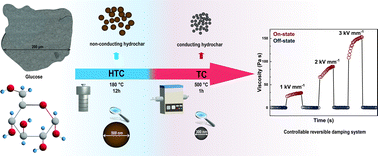Semi-conducting microspheres formed from glucose for semi-active electric field-responsive electrorheological systems
Abstract
In this study glucose particles were successfully transformed to conducting carbonaceous microspheres through sequential hydrothermal and thermal carbonization. The prepared carbonaceous particles were thereafter used as a dispersed phase in a novel electrorheological fluid. Due to significant enhancements of the conductivity and dielectric properties when compared with the glucose precursor, the prepared electrorheological fluid based on carbonaceous microspheres exhibited a yield stress of over 200 Pa at a particle concentration of 5 wt% at an electric field intensity of 3 kV mm−1, and overcomes recently published novel electrorheological fluids and others based on carbonized particles. In order to estimate the exact rheological parameters, the measured data were treated using a mathematical model Cho–Choi-Jhon, and the reproducibility and reversible possibility to control the viscosity of the novel prepared electrorheological fluid were confirmed through time dependence tests at various electric field intensities. Not only did this approach lead to carbonaceous conducting particles with high performance in electrorheology, but the yield after carbonization at 500 °C was also 60%. It was thus confirmed that unique carbonaceous conducting particles were prepared using a sustainable method giving high yields, and can be potentially used in many other applications where such carbonaceous particles are required.



 Please wait while we load your content...
Please wait while we load your content...